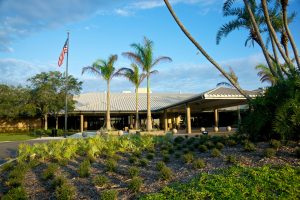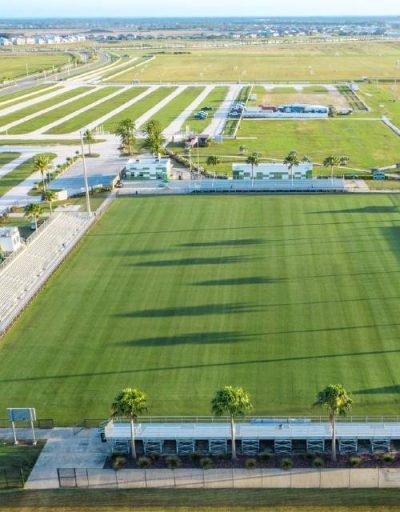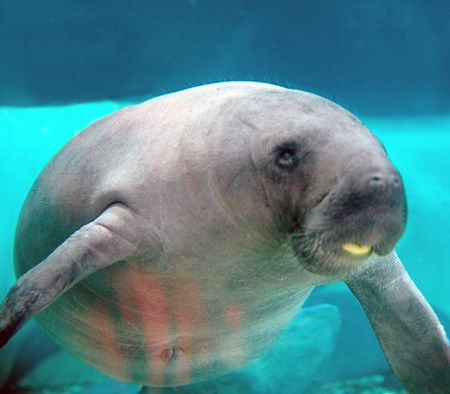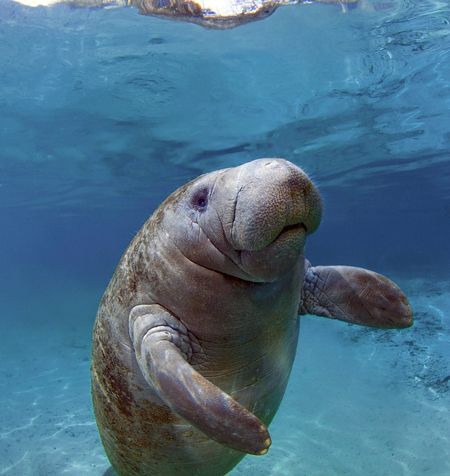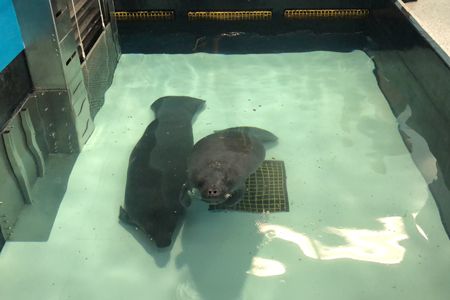All About Manatees
Looking for manatees
Where to find Florida’s not-so-little landscapers
What exactly is the purpose of a manatee?
Is it just to give algae something else to grow on? Is it to inspire choruses of “AWWWWs” at the sight of their sweet, gentle faces? Or, since they sleep up to 12 hours a day, do they have any purpose at all?
Do they even need one?
According to Virginia Edmonds, Director of Animal Care at the Bishop Museum of Science and Nature, manatees do play a very important role in the shallow rivers, bays, estuaries, canals and coastal waters they call home.
“They’re really the only marine-mammal herbivore in Florida,” she explains. “They are like little landscapers in the water.” By eating fast-growing native and invasive species. “They definitely manage our waterways and waterbeds out there.”
So what exactly are they?
With thick wrinkled skin, slender front flippers, and a long cylindrical body that taper down to a mighty flat tail, manatees, at first glance, seem to defy classification.
In actuality, they’re mammals, just like us. That means they have some type of hair or fur on their bodies, are warm-blooded, and are born alive and relatively well-developed. They also can live to be quite old – up to 60 years or more.
Despite the fact that someone decided to hang upon them the less-than-flattering “sea cow” moniker, they are actually more closely related to elephants – as anyone who’s ever looked one straight in the eye could probably tell you.
And like elephants, our manatees are deeply loved and admired by locals and visitors alike, so much so that they’ve been named Florida’s state marine mammal. And you might have noticed, the Bradenton Area sits squarely in Manatee County.
What can we say? We love our manatees! And we’re not the only ones. That’s why people get so excited when they see them.
Where you can find manatees?
To see manatees, you only need to look toward the warm, shallow waters around the Manatee River, canals, beaches or any of our parks near open water. And you don’t have to look out very far.
“They’re not deep-water animals,” Virginia says. “If you go out on a boat and you’re going out a couple miles, you’re not going to see manatees out there. You can see them near shore because they eat plants.”
Plants grow in shallow water where they can get plenty of sunlight, which the manatees love. “Manatees also like it warm so they stay shallower for warmth,” she adds, “but they definitely have to eat shallow because their plants grow that way.”
That means, in the summertime when the waters are warmest, they can be in waters anywhere. “There’s not a specific place. They’re just gonna be moving all around,” Virginia explains.
But there are clues to look for.
You may see a little swirl on the surface after a manatee dives. Or you could spot an animal’s back, snout, tail, or flipper break the surface of the water. Or you might only hear one surface to grab a breathe of air.
In the wintertime when the waters cool, finding manatees becomes much easier – if you know where to look. And the location may surprise you.
“When it gets cold… manatees all over the state of Florida travel to their warm-water sites,” Virginia explains. “And most of the time those are power plants.”
“Then you can see hundreds of them,” she continues.
Despite their bulbous bodies, “manatees, in general, don’t have a lot of body fat,” she says. “Manatees are really cold intolerant. They get cold stress in the wintertime.” So the warm water pumped out by power plants does nicely.
“Usually ours travel to the Teco Power Plant,” Virginia notes, which is about a 40-minute drive north, up near Tampa. Also, manatees favor the many natural freshwater springs all over Florida, where temperatures remain warm all year – on average around 70 degrees.
Anything less won’t do. “For them, 68 or below is cold,” Virginia adds.
From Bradenton, the closest is Weeki Wachee Springs State Park (about two hours to the north). And just a bit farther up are the Crystal River National Wildlife Refuge and Three Sisters Springs, one of the most important areas for wintering manatees.
Manatee dos and don’ts
Manatees inspire awe and wonder in all of us. It’s only natural to want to get a closer look. But it’s equally important to be respectful of their habitat and health.
“If you do see a manatee,” Virginia warns, “it’s always recommended for passive observation.” In other words, you can look, but don’t touch.
“It’s illegal to harass them. You can’t ride them. You can’t grab them. You can’t make them stay with you,” she advises. “And all those things would be really unfair to do to the animal anyway.”
And please don’t feed them. “It’s illegal,” she adds, “because anything you do like that changes their behavior,” making them dependent on people and opening them up to greater harm.
But “because manatees are such nice guys,” Virginia understands the temptation. “We do run across a lot of people who are like, ‘I love manatees! I threw ’em a head of lettuce,'” she tells, “And we’re like, ‘ohhhh, that’s so nice of you, but don’t do that.'”
“But I appreciate people wanting to be kind to them,” she adds. “That is always a lovely thing to hear.”
What to do if you spot an injured manatee
Because manatees are such shallow-water creatures, they are susceptible to many types of injuries. According to Virginia, the two most common are being run over or hit by boats.
But many other dangers exist. “They get entangled in crab-trap line and monofilament line,” Virginia notes, “They get cold stress. They could be orphaned. And they can ingest things.”
They can also become entrapped in areas during large storms and hurricanes. “They can end up in a lake and be isolated, where they can’t get out of the lake and there’s no food.”
If you witness a sick, injured or orphaned manatee, call 1-888-404-FWCC (3922) or send a text message or email to Tip@MyFWC.com
Rehabilitation at the Bishop
One place where you’re guaranteed to find a manatee or two is at The Parker Manatee Rehabilitation Habitat – inside the Bishop Museum of Science and Nature – which serves as temporary home for manatees that will be released back into the wild after they have returned to health. Overall, the Bishop has helped rehabilitate more than 40 manatees since 1998.
“The guests who come in here are so receptive to the rehab and they absolutely love it,” Virginia recalls excitedly. “We love to share the information. We want them to learn about manatees and know that there’s a rehab program for them.”
“We receive such good feedback and people are so interested, she adds. “We will be out there for 25 minutes on a presentation and then we’ll spend another half hour answering questions. People are so interested in the animals.”
Which bring us back to purpose… Do manatees even need one?
“We often get that question: ‘What good are manatees?'” Virginia says, “I always go, ‘Well, I don’t know.’ If people need a purpose for them to be here, you know, then that’s a purpose.”
She continues, “I don’t always think that animals need a purpose. I think that they are amazing. We should enjoy them, their beauty and how interesting they all are and how different they all are.”
“I think animals add to the beauty and I know many people feel that way.”
For more information about manatee rehabilitation, to schedule a visit, or make a donation, please visit bishopscience.org



